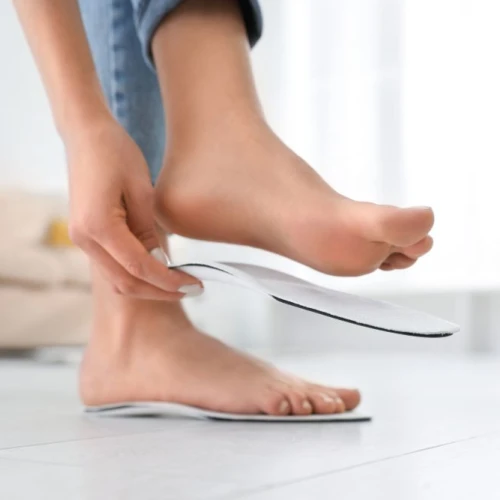What is an orthopaedic insole?1
Orthopaedic insoles are medical devices that can only be obtained with a medical prescription from a doctor or pedicurist/podiatrist. Custom-made orthopaedic insoles are produced to correct a foot problem that is causing discomfort (pain, difficulty walking, lack of balance, weight-bearing areas that are painful or dangerous for health, etc.). They are used in shoes adapted to accommodate the extra volume to ensure the device is used properly.
Note: orthopaedic insoles differ from mass-produced insoles used for comfort and available without a prescription.
How do you know if you need an orthopaedic insole?1, 2
Orthopaedic insoles are prescribed for people unable to put their feet down properly, leading to imbalances that cause foot, knee or back pain.
Thus, a doctor or a pedicurist/podiatrist may prescribe orthopaedic insoles in the following cases:
- Foot pain (toes, heels, ankles, sole and/or back of foot);
- Knee, hip or back pain;
- Foot malformation (flat feet, claw feet or hallux valgus);
- Poor gait or change in posture;
- Shoes that are deformed and wear out rapidly;
- Poor alignment of a bone or joint;
- Unstable joints;
- Prevention of musculoskeletal deformities;
- Stabilisation of existing musculoskeletal deformities;
- Reduction of high plantar pressure and stress on tendons and muscles.
Orthopaedic insoles may also be prescribed as a preventive measure even in the absence of any troublesome symptoms, in:
- Athletes, as their are joints are placed under considerable stress;
- People over the age of 75 years;
- Diabetics;
- People who have one leg shorter than the other.
How are orthopaedic insoles made?1, 2, 3
Pedicurists/podiatrists, pedorthists, orthoprosthetists and orthopaedist/orthotist can manufacturer orthopaedic insoles. They are designed in three stages.
Podiatry assessment
A podiatry assessment or postural assessment, which lasts for 30 to 45 minutes, is the first stage. During the assessment, the pedicurist/podiatrist will ask the patient about his or her symptoms, medical history and daily and sporting activities. The first stage of the assessment is also an opportunity for the podiatrist to look at the various examinations already performed (MRI, X-rays, CT scan, etc.). The podiatrist will then palpate the foot to pinpoint the painful area/s and identify which areas need to be corrected. During the palpation, the podiatrist will take measurements, check the amplitude of the joints and test the muscles.
A static examination is then performed which consists of analysing the standing position with two immobile feet. The foot specialist then performs a dynamic examination to analyse the patient’s gait. The podiatry assessment ends with an analysis of the footwear (street shoes, work shoes, safety shoes and sports shoes) and takes a mould of the foot to ensure the orthopaedic insoles can be made to measure.
Designing orthopaedic insoles
When designing orthopaedic insoles, the specialists use the description of needs set out in the podiatry assessment and the mould of the patient’s feet. The base is made out of thermo-moulded resin which is fitted to the size of the patient’s foot then adjusted to the type of need. In some cases, reinforced areas can be added.
Testing the orthopaedic insoles
When the insoles are ready, they are tested by the patient to check they correspond to the needs identified during the podiatry assessment. Patients can request an outer covering suited to their own tastes, for greater appeal and comfort.
Patients are invited to attend another appointment with the pedicurist/podiatrist within two months after receiving the insoles to check they are effective.
How long do they last?2
Orthopaedic insoles can be used for one year on average. However, this time will vary from patient to patient. It depends on the weight of the person, their activities and the progression of the initial symptoms.
What is the average price of an orthopaedic insole?
A pair of orthopaedic insoles costs between €100 and €200 on average (the price varies depending on the shoe size).


